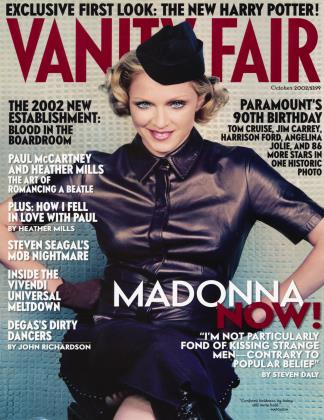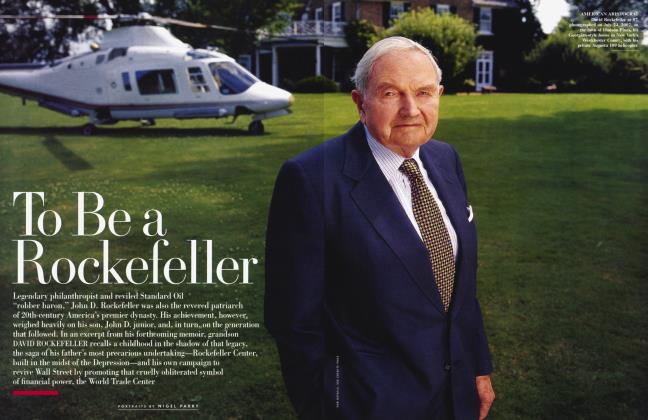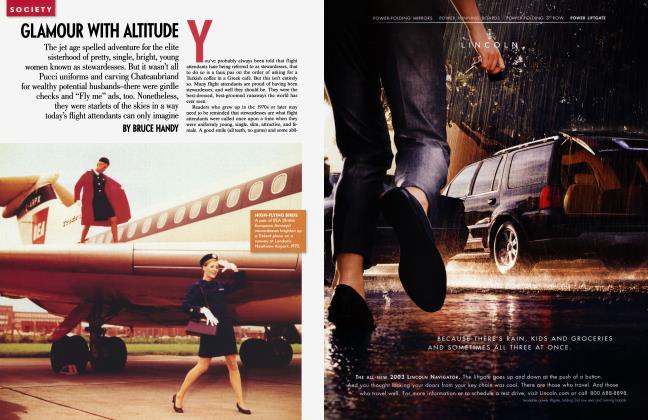Sign In to Your Account
Subscribers have complete access to the archive.
Sign In Not a Subscriber?Join NowCONTRIBUTORS
With the publication of Memoirs, excerpted in this issue, David Rockefellergrandson of Standard Oil founder John D. Rockefeller Sr. and youngest son of the great philanthropist John D. Rockefeller Jr.—has opened a window onto his extraordinary experiences as a scion of one of New York City's most important families. In his 35-year career with Chase Bank, during which he served as chairman and C.E.O., Rockefeller became a leading spokesman for the business community, worked tirelessly on philanthropic projects in New rk and elsewhere, and facilitated numerous development and revitalization campaigns, including the one to build the World Trade Center.
"The idea of interviewing Madonna was a little daunting," says contributing editor Steven Daly, who first met the icon backstage after a performance of her recent West End play, Up for Grabs, and then again at her Beverly Hills home as she and her husband, director Guy Ritchie, were preparing for the October release of their movie, Swept Away. "She is known as a tough interview, but I found her surprisingly easygoing." So easygoing that when Daly spied an acoustic guitar in her home he teased her about sitting around and playing the campfire classic "Kumbaya." "She took it in quite good spirit," says Daly, whose profile of Madonna begins on page 308.
Senior articles editor Bruce Handy's introduction to the world of stewardesses, or flight attendants, as they now prefer to be called, was as a kid seeing copies of Coffee, Tea or Me? on the spinning paperback rack at the local drugstore. "I remember thinking that it was this incredibly smutty, dirty, alluring book," he says. After finally reading it for his piece on "stews" and meeting many retired flight attendants, Handy learned that the glamorous world of 60s air travel was "fascinating not because it was so sex-crazed— which it wasn't—but because in many ways stewardesses were proto-feminists. On the one hand they were businessman bait. But at the same time, it was pretty much the only job that was open to women with a sense of adventure. I came to admire them."
CONTINUED ON PAGE 110
CONTINUED FROM PAGE 96
For contributing photographer Todd Eberle, the chance to shoot the newly renovated Lever House not only fed his admiration for architect Gordon Bunshaft, but also held a personal connection. "Last year I was looking for property in Connecticut and happened upon a house designed by Louis Skidmore, Bunshaft's associate, that had been taken off the market because no one wanted it," says Eberle. "I bought it that day." Eberle sees places such as Lever House as enlightened examples of modernism. "The greatest thing for me was that someone made a decision that it was worthy of saving. I think in a world where they're tearing down Bunshaft buildings, leaving things be and seeing how the tastes change is a great inspiration."
Editor-at-large Matt Tyrnauer often writes about design, from the high to the low and everything in between. This month, on page 318, he examines historic Lever House and its brilliant, enigmatic, and irascible architect, Gordon Bunshaft. "Bunshaft is one of the great modernists, but also one of the most unexplored and unappreciated," Tyrnauer says. "Lever House was his first major building, and it turned out to be the glass box par excellence, a masterpiece that changed design forever." Tyrnauer also edited the New Establishment power list, which chronicles one of the most tumultuous years in the modern history of corporate America.
On page 324, contributing editor Leslie Bennetts profiles Heather Mills, now Lady McCartney. According to Bennetts, Mills "elicits very powerful reactions from people, who seem to either adore her or hate her." Bennetts, who met with Mills at her house on the southern coast of England, found her life story fascinating. "I was delighted to be able to spend time with her," Bennetts says, "since she is extremely angry about her treatment by the British press and very wary of reporters." Though Mills is still in the honeymoon phase of her marriage to Sir Paul McCartney, Bennetts believes the real test of her character lies ahead. "Now that she's Lady McCartney and can do pretty much anything she wants to do, her choices will be very revealing."
FOR DETAILS, SEE CREDITS PAGE
CONTINUED ON PAGE 112
CONTINUED FROM PAGE 110
On page 330, contributing editor John Richardson examines Edgar Degas's series of paintings of 19thcentury French ballerinas (or "little rats," as the corps of dancers were then called). "What I'm trying to do is make people see Degas's dancers in a new light," Richardson says of the young women often captured in unglamorous and strenuous poses while at rehearsal. "Instead of sentimentalizing them, I portray them as victims of Degas's scathing, unromantic vision." Richardson, whose most recent book is Sacred Monsters, Sacred Masters, is completing the third volume of his award-winning biography of Picasso, to be published in late 2003 by Random House.
He has photographed stars such as Gwyneth Paltrow and Robert De Niro, but fashion photographer Craig McDean confesses that he doesn't "generally enjoy shooting celebrities." His experience with Madonna, whom he captured in an iconic Man Ray style for this month's cover story, may change that, however. "Usually you just show up," McDean says, "but Madonna is so image-conscious that she wants to meet you beforehand and to know how you plan to represent her." A native of Manchester, England, McDean is a regular contributor to Vogue. This is his first Vanity Fair assignment.
For contributing artist Hilary Knight—who brought everyone's favorite Plaza resident, Eloise, to life in four classic books,—Eloise Takes a Bawth was "an opportunity to re-do something I didn't absolutely love, 40 years later." The original idea was conceived in the 1960s, but both he and author Kay Thompson decided not to publish it, agreeing that it was not their best work. Fast-forward to 1998, when Vanity Fair reproduced some of Knight's sketches and sparked a new interest in the little girl. The text was edited, new drawings rendered, and the long-awaited book is due out this month. "So here's Eloise fresh from her 40-year bath," Knight says. "Wrung out, starched, and ironed. Completely refreshed and still only six."
FOR DETAILS, SEE CREDITS PAGE
CONTINUED ON PAGE 117
CONTINUED KROM PAGE 112
During his 18 years as a V.F. contributing photographer, Bruce Weber has shot his share of gorgeous creatures, Carolyn Bessette Kennedy and Jude Law among them. This month, Weber hit the mother lode, photographing the five stunning Noel sisters. "I was lucky when I got a chance to photograph them because all five are intelligent and beautiful, play hockey, and sing at their best friends' weddings," says Weber, whose black-and-white portraits start on page 338. "And," he adds, "they don't have to worry about clothes for all their children, because their mother [Monica Noel] has been making the most beautiful clothes for years." Weber is currently working on a new film about C. Z. Guest, as well as a new book, due out this fall.
Growing up with fashion designer Carolina Herrera as her mother, Patricia Herrera insists, did not predetermine her career as Vanity Fair's fashion editor. She admits, however, that "my mom's closet was a pretty great place to play dress-up in." Now when a photographer imagines a V.F. photo subject in, say, 19th-century riding clothes, Herrera and her colleagues search everywhere from Manhattan's Lower East Side to flea markets in Paris to find the perfect match. This fall she prepares her biggest project yet—her wedding. Her fiance, Gerrity Lansing, a stock trader who owns his own company, is proof that opposites attract. "He has no idea about shopping," says Herrera. "He doesn't even know where Barneys is."
For this month's issue, Nigel Parry photographed David Rockefeller at his residence just north of Manhattan. "He was perhaps one of the most humble people I've ever photographed," Parry says. "It was also very poignant because he was instrumental in building the World Trade Center. He described his sadness for the poor people who were in it when it fell." Parry's most recent book, Sharp, is a collection of his black-and-white work. He is currently collaborating with photographer Melanie Dunea on a book, Precious (Powerhouse), for the Starlight Foundation, a charity for terminally ill children. "It's all about what different sorts of people find precious about their body."
 View Full Issue
View Full Issue






Subscribers have complete access to the archive.
Sign In Not a Subscriber?Join Now